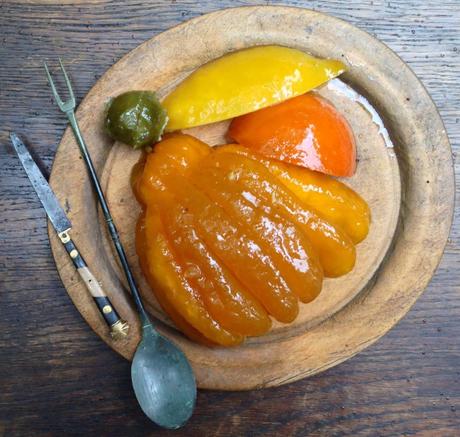
A selection of 'wet suckets' - citrus fruits preserved in syrup. Clockwise from top left - green orange, lemon, bitter orange and citron succade on a wooden trencher with a Tudor fruit knife (ca.1560) and a sucket fork (ca.1680-1700). The sucket fork is made of the copper alloy latten and would originally have been tinned to make it safe to use. In its uncleaned condition it would not be usable and is just posing here to look nice.
A short while ago a friend gave me a gift of the late seventeenth century sucket fork illustrated above, now a much treasured addition to my small collection of early eating knives and flatware. I already own a silver sucket fork, a fairly high status object, but my new one is made of latten, a lowly utilitarian alloy of copper. It may once have been owned by a diner who was refined enough to indulge in expensive luxury foods, but not rich enough to afford tableware made of precious metal. Or perhaps it came from a tavern or ordinary. The fork end was designed for spearing sticky suckets, (preserved citrus peels), while the small spoon was used for supping up the unctuous and flavoursome syrup in which they were stored. Amazingly, double ended spoon/forks similar to this were in use in England well before the Norman Conquest. An Anglo-Saxon horde of silver excavated at Sevington in Wiltshire, now in the British Museum, includes a pair of spoons with fork blades at the handle ends. These have been dated to the 9th century from some coins of the period contained in the same horde. Sucket forks were probably the first forks to be used in England, though what purpose these early Anglo-Saxon examples served remains a mystery, as sugar was unknown in Britain at this time.*
My other sucket fork, this time made of silver. Provincial English, probably by Joseph Hicks of Exeter ca.1770.
Half a millennium later, Henry VIII possessed a similar object. The jewel house inventory of his goods includes, 'Item one spone wt sucket forke at thende and gilt poz one oz iii quarters'. A sucket fork is also mentioned in Edward VI’s estate household silver inventory of 1549. These royal examples, gilded and no doubt highly embellished, were a world away from my humble latten example, which at some time has been tinned over to prevent the copper alloy from tainting the food. Traces of the tinning remain here and there, but most has worn off. My friend bought it in a job lot at a sale, with sadly no indication of its provenance, though we both suspect it may be a metal detector find. The veneer of verdigris on its surface certainly indicates that it could have been buried underground for a long time. Individual silver sucket forks are pretty scarce, full sets are much rarer, but ones made of a cheap metal like latten seem to be the rarest of all. In fact mine is the only one we both have ever seen.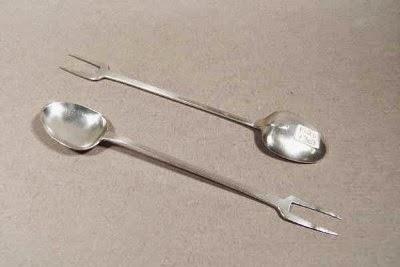
Pair of silver sucket forks by Elizabeth Tookey, London 1675-1700. Photo © Manchester City Galleries

Late seventeenth provincial English sucket spoon and fork. Photo © M. Ford Creech Antiques.
Despite much earlier archival records most of the sucket forks that have survived date from the middle of the seventeenth century onwards. They were still being made in the late eighteenth century. Similar implements were also produced on the continent, particularly in the Netherlands. There are also a few colonial Dutch and English examples made in North America in the late seventeenth and early eighteenth centuries, like the one below I saw at Yale last year.
Silver sucket fork ca.1680–90 made by Jesse Kip (1660 - 1722) in New York City. The long handle is engraved with the name of the owner - Maria van Rensselaer (1673-1713. The Rensselaer family were a prominent New Amsterdam colonial family with a large estate near Albany. Photo © Yale University Art Gallery.
Sucket forks, sometimes also referred to as sucket spoons, should not be confused with sweetmeat forks, which do not have a spoon at the opposite end. These are also frequently mentioned in medieval and renaissance inventories, with a number of English examples surviving from as early as the fourteenth century. A nice sixteenth or early seventeenth example excavated from the site of the Rose Theatre can be seen in the Museum of London. It may have been mislaid by a theater goer at the time of Shakespeare.
Sixteenth or early seventeenth century sweetmeat fork.Photo © Museum of London
Sweetmeat forks were among the first British forks to be included in sets of flatware. The two late seventeenth century trefid examples in my collection illustrated below have become separated from their matching knives and spoons, but would have been part of a dessert set that graced a banquet table during the reign of James II.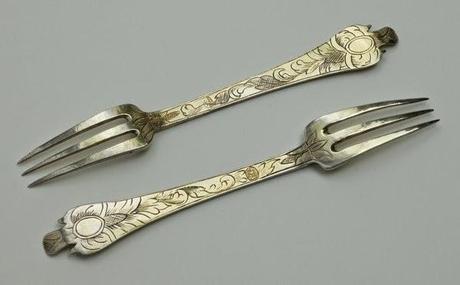
Pair of English trefid sweetmeat forks, silver gilt. Unascribed ca.1685.
Sucket forks obviously derived their name from the suckets which they were used to spear. 'Sucket', 'soket', or 'suckitte' is a corruption of French succade, generally meaning a fruit, root or citrus rind preserved in sugar syrup. More specifically, the word was often used to described a preserve made from the peel of the cedro or citron (Citrus medica L.). In a glossary of definitions of imported goods published by the customs officer James Smyth in The Practice of the Customs. (London: 1821), we are told, 'The peel of Citron preserved in sugar, and all other moist sweetmeats not particularly enumerated in the table of duties, are denominated Succades.' I heard a discussion the other day about citron on the BBC Radio 4 programme The Kitchen Cabinet, in which it was stated that citron was the first citrus fruit to come to Britain. I am not sure that this is true, but would love to hear the evidence that it is based on.Most etymologists assume the word succade is derived from the Latin succidus - 'juice', or from French sucre - sugar. There is however, a suspicion (though no real proof). that it evolved from the Hebrew סוכות - sukkot or sukoth. Sukkot, or the Feast of Tabernacles, is an ancient Jewish religious rite at which citrons are displayed with willow branches, myrtle and palm fronds in a temporary booth known as a סוכה (sukkah). Specially selected citrons, known as etrog are still used in the ceremony. Citrons are a genetically capricious fruit with numerous morphological variations. To be kosher the citrons used at Sukkot, must have certain fixed characteristics, which distinguishes them from normal everyday citrons.. One of these required features can clearly be seen in an engraving in a book on citrus fruits published by the Nuremburg merchant Johann Volckamer in 1714. In his caption Volckamer refers to this particular variety by its Italian name - cedro col pigolo - the pigolo being the small persistent style at the flower end of the fruit, which in Hebrew is called the pit am. Citrons that have a good pit am are sold for very large sums of money as they are considered to be the purest form of the fruit. In his text, Volckamer gives his native German name for this variety - Juden Citronatapfel - the Jewish citron.
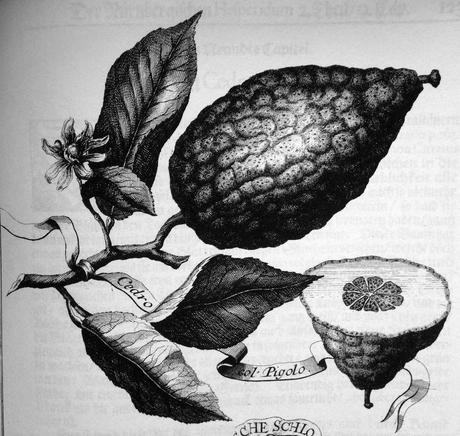
The etrog, Juden-citronapfel, or cedro col pigolo. From Johann Christoph Volkamer, Nürenbergische Hesperides. (Nuremburg 1728 edition).
Volckamer's book is one of the most beautiful botanical works from the baroque period. Unfortunately, its wonderful engraved plates are very attractive to print collectors, so many copies have been broken up by dealers who sell the plates on for large sums of money. I am lucky enough to possess a complete copy in its uncoloured state. The author lists and illustrates eleven different varieties of citron, or cedri as they were called in the Italian peninsula. These fruits have dry inedible pulp and no juice, but are usually thick skinned, which makes them ideal for preserving as succade. Some grow to a very large size and monstrous, often deformed varieties were much admired by Italian noblemen who grew these fashionable expressions of horticultural mannerism in extensive citrus gardens.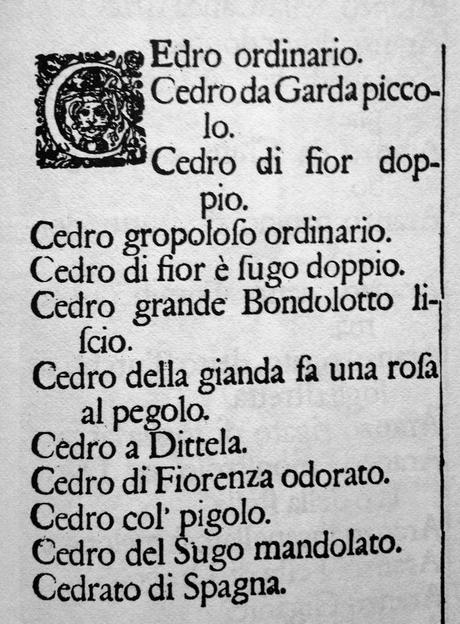
From Johann Christoph Volkamer, Nürenbergische Hesperides. (Nuremburg 1728 edition().
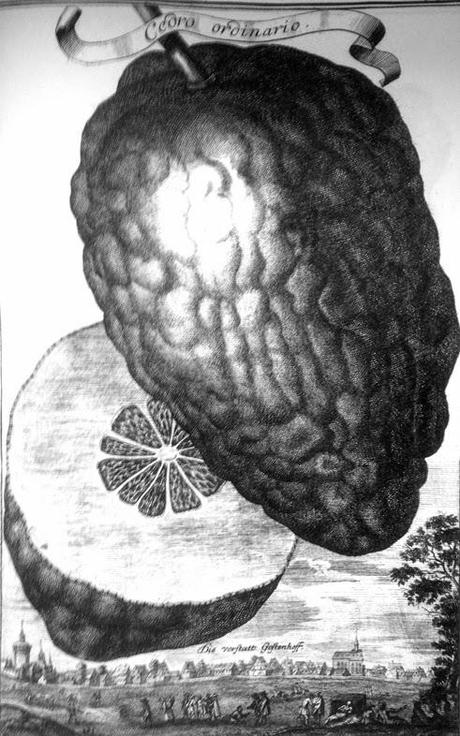
Cedro ordinario - the common citron. From Johann Christoph Volkamer, Nürenbergische Hesperides. (Nuremburg 1728 edition().
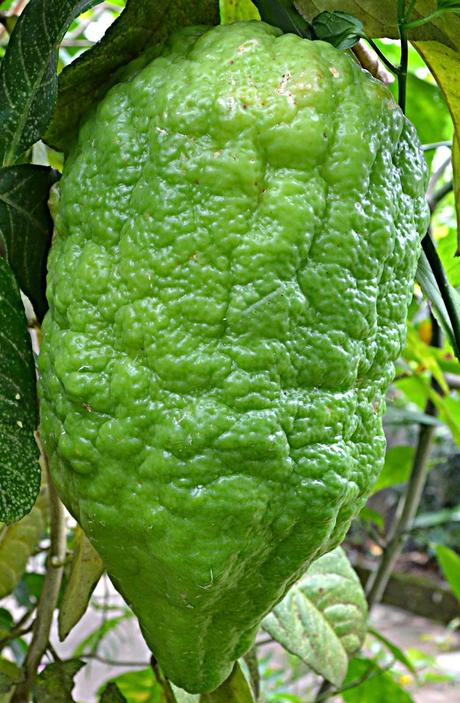
The common citron in its unripe, green state. This single specimen weighted 2.7 kilos.
Some renaissance scholars and poets liked to think that oranges, lemons and citrons all grew in the famed Garden of the Hesperides. Many were of the opinion that the orange was the most likely candidate for the mythical golden apple of the Hesperides, which endowed those who ate it with immortality. However, oranges were unknown in antiquity. Volckamer actually structured his book with chapter headings based on the names of the three nymphs of the Hesperides who tended the Garden - Aegle, Aerethusa and Hesperethusa. He places Aegle in charge of citrons, Aerethusa in charge of lemons while Hesperethusa looks after the oranges. At the beginning of each chapter is an engraving showing each nymph in her part of the garden. That reproduced below shows Aegle, who is holding a large common citron in her left hand.
From Johann Christoph Volkamer, Nürenbergische Hesperides. (Nuremburg: 1728 edition).

Harmonillus transformed into a citron tree, a plate from G.B. Ferrari, Hesperides sive de malorum aureorum cultura et usu. Rome 1646 Engraving Cornelis Bloemart after Andrea Sacchi. The original drawing for this image is in the Louvre.
As well as featuring in Judaic religious rites this fruit, now of very little economic significance, also played a role in classical mythology, or at least in versions of the myths as imagined by renaissance scholars. The most striking of these 'myths' about the citron was invented by Giovanni Battista Ferrarii, a Jesuit priest from Sienna, who published a monograph on citrus fruits in Rome in 1646. Ferrarii based his self-styled tale on similar legends from antiquity, like that of Apollo and Daphne as told by Ovid, in which a nymph is transformed into a tree. In his book Hesperides sive de malorum aureorum cultura et usu. (Rome 1646), Ferrari illustrated the metamorphosis of a young man called Hamomillus into a citron tree. I have reproduced a detail from his engraving above. Hamomillus's feet are rooting to the ground while his fingertips are turning into branches bearing citron fruit. The citrons growing out of his hands are quite unlike the common citron illustrated above. They are multi-lobed and possess finger-like lobes. Varieties of citron which had this aberrant hand-like form were common in seventeenth century Europe. Ferrari refers to this kind as malum citreum multiforme - the multiform citron, while his German disciple Volkamer called the variety cedro a ditella - the finger citron. Here are their illustrations of these monstrous varieties.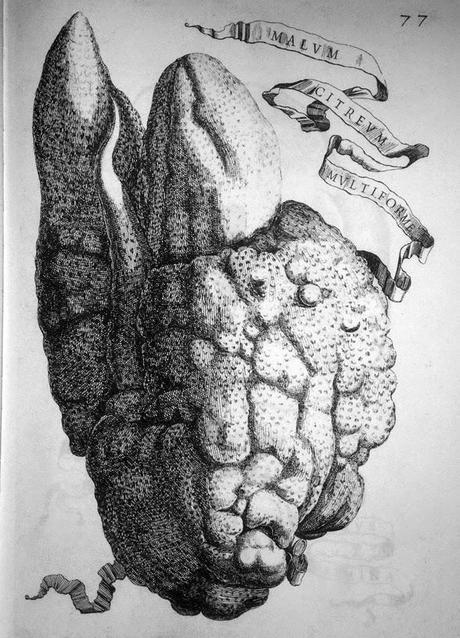
G.B. Ferrari, Hesperides sive de malorum aureorum cultura et usu. Rome 1646 caption

From Johann Christoph Volkamer, Nürenbergische Hesperides. (Nuremburg 1728 edition).
This very old variety still survives and is usually called the Buddha's Hand Citron. It is widely grown in the Far East and is frequently used as an offering in Buddhist Temples. But it is also cultivated in the US and Italy, where it has been known for at least four hundred years. In China, Vietnam and Japan, it is not used much in the kitchen. Its flavor and scent are not really different to the common citron, but it is becoming fashionable among chefs these days, who have probably been attracted by its outlandish appearance.
I have found Buddha's Hand citrons in Wholefoods in the US, though I purchased these two in a market near Hanoi in Vietnam.
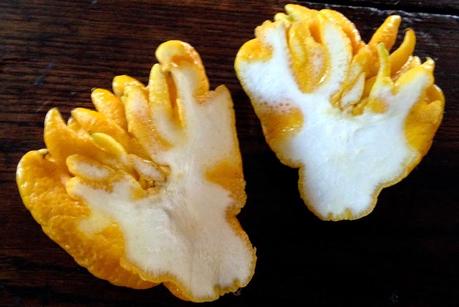
Like other varieties of citron, finger citrons have no juicy flesh or pips.
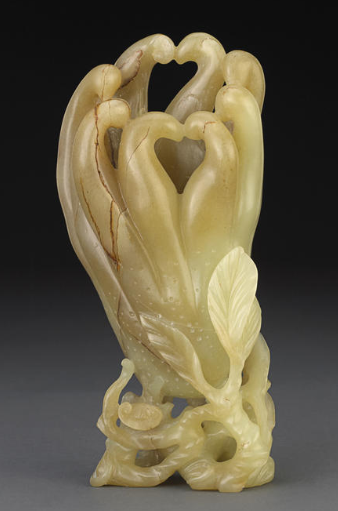
Buddha's Hand citrons frequently feature in Chinese art. This jade carving dates from the seventeenth century.
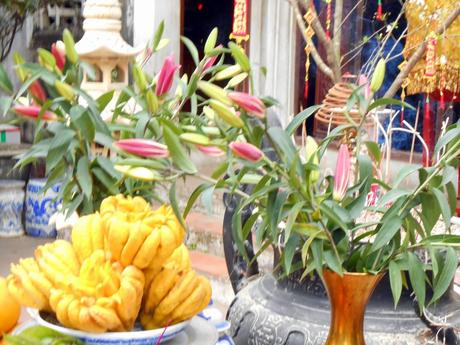
Buddha's hand citrons on an altar in a temple in Vietnam.

I preserve citrons and other relatives, like the bitter orange and pomelo rinds here by first poaching the rinds in boiling water until they are soft. I then poach them briefly in a thin sugar syrup for just five minutes. I leave them to steep in this syrup for twenty four hours, then remove the fruit from the syrup, which I boil for five minutes. The thickened syrup is poured over the fruit and the whole process repeated for twelve days altogether. I leave the fruit in the thick syrup. It is much more succulant and flavoursome than any commercial candied fruit.
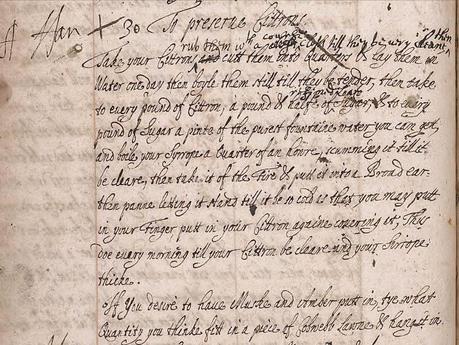
I more or less use this technique described by Lady Anne Fanshawe for preserving citrons. It works very well with other citrus fruit. Courtesy Wellcome Library.
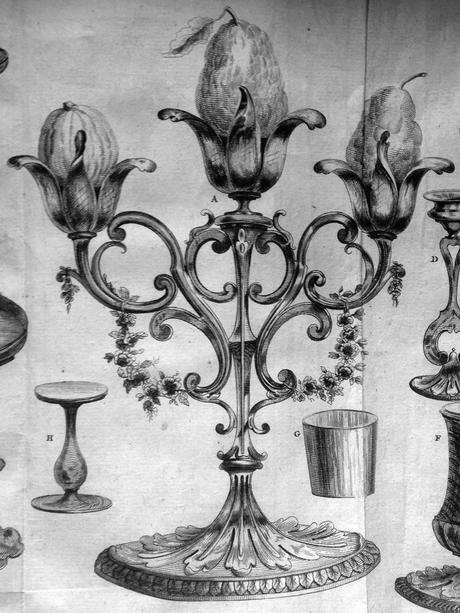
Whole preserved citrons were an important decorative feature of the baroque dessert course. This silver citron display stand is one of a number illustrated in Joseph Gilliers, The Cannemeliste français. (Nancy: 1751). If objects like this were actually made, none appear to have survived.
*Hawkins, E. (1838): 'An Account of some Saxon Pennies and other articles, found at Sevington, North Wilts'., Archaeologia, xxvii, 305-5 and pl. 24; Fairholt, F. W. (1857): Miscellanea Graphica, London, pl. 18, 1; Jackson, C. J. (1893): 'The Spoon and its history; its form, material and development, more particularly in England', Archaeologia, liii, 117; Wilson, David M, Anglo-Saxon Ornamental Metalwork 700 - 1100, in the British Museum, London, BMP, 1964.
